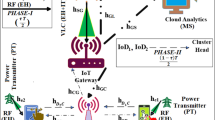Abstract
The medium access control (MAC) protocol for indoor visible light communication (VLC) with energy harvesting is explored in this paper. The unfairness of throughput exists among devices due to the significant difference of their energy harvesting rates which changes with distance, acceptance angle and the obstruction probability. We propose an energy harvesting model, a new obstruction probability model and an energy adaptive contention algorithm to overcome the unfairness problem. This device can adjust its contention window according to the energy harvesting rate. As a result, the device with lower energy harvesting rate can get shorter contention window to improve its transmission opportunity. Simulation results show that our MAC protocol can achieve a higher degree of fairness.
Similar content being viewed by others
References
Liu Y., Hsu C. W., Chen H. Y., Liang K., Chow C. W. and Yeh C. H., Optical Engineering 54, 120502 (2015).
Hai-feng Yu, Xue-fen Chi and Jian Liu, Optoelectronics Letters 10, 365 (2014).
Liu Y., Yang Z., Yu R., Xiang Y. and Xie S., Access IEEE 3, 358 (2015).
Naderi M. Y., Nintanavongsa P. and Chowdhury K. R., IEEE Transactions on Wireless Communications 13, 3926 (2014).
Haas H., Visible Light Communication, IEEE Optical Fiber Communications Conference and Exhibition, 107 (2015).
Ramos J. S., Demirkol I., Paradells J., Vössing D., Gad K. M. and Kasemann M., Towards Energy-Autonomous Wake-Up Receiver Using Visible Light Communication, 13th IEEE Annual Consumer Communications & Networking Conference, 544 (2016).
Kunikawa M., Yomo H., Abe K. and Ito T., A Fair Polling Scheme for Energy Harvesting Wireless Sensor Networks, IEEE 81th Vehicular Technology Conference, 1 (2015).
Lin H. H., Shih M. J., Wei H. Y. and Vannithamby R., Wireless Networks 21, 357 (2015).
Kim J. and Lee J. W., Energy Adaptive MAC for Wireless Sensor Networks with RF Energy Transfer: Algorithm, Analysis, and Implementation, Telecommunication Systems, 1 (2016).
Kim J. and Lee J. W., Energy Adaptive MAC Protocol for Wireless Sensor Networks with RF Energy Transfer, 3rd International Conference on Ubiquitous and Future Networks, (2011).
Chun-yue Wang, Lang Wang and Xue-fen Chi, Optoelectronics Letters 12, 69 (2016).
IEEE Std. 802.15.7-2011 - IEEE Standard for Local and Metropolitan Area Networks—Part 15.7: Short-Range Wireless Optical Communication Using Visible Light, 1 (2011).
Author information
Authors and Affiliations
Corresponding author
Rights and permissions
About this article
Cite this article
Wang, Hq., Chi, Xf. & Zhao, Ll. Energy adaptive MAC protocol for IEEE 802.15.7 with energy harvesting. Optoelectron. Lett. 12, 370–374 (2016). https://doi.org/10.1007/s11801-016-6163-6
Received:
Published:
Issue Date:
DOI: https://doi.org/10.1007/s11801-016-6163-6




